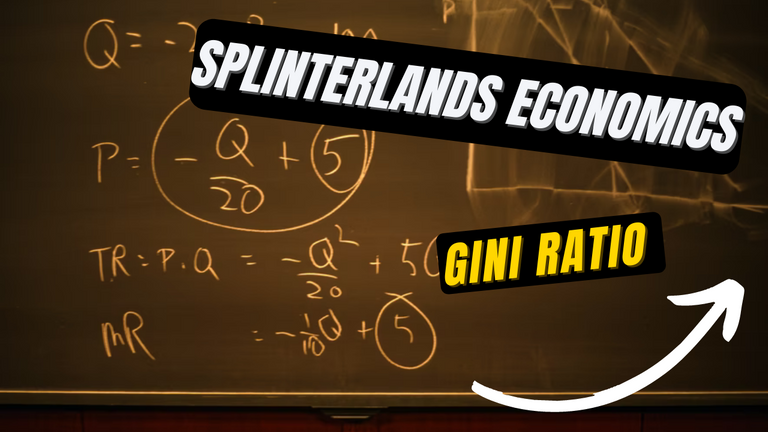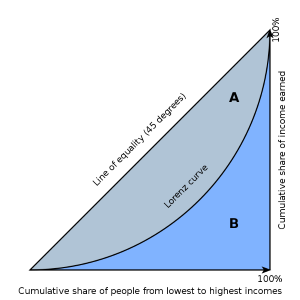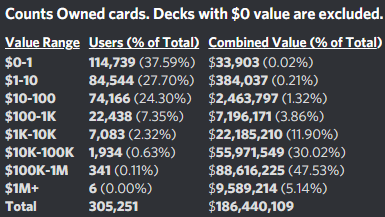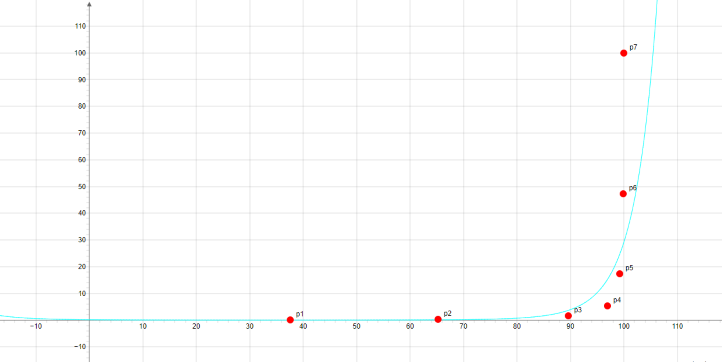Splinterlands Economics: The Gini Ratio
Hello everyone! We are back again today with another edition of Splinterland Economics - a series in which we introduce a basic economic concept and then apply it to Splinterlands. If this is your first time reading, just to tell you a little bit about myself: my day job is in an unrelated area but I consider myself a little bit of economics nerd - I read a little (or maybe way, way) more news than I should, double majored in econ, and am obsessed with optimization. I love the way Splinterlands is equal parts card game and resource allocation game. My goal with these articles is to share a little bit of what I know with you all.
Our topic this week is the Gini Ratio. This is a concept that may be a little less practical in your day to day gameplay, but understanding the concept gives us some insight into the Splinterlands economy on a large scale. For me personally, looking at Splinterlands taking this concept into account gave me a brand new appreciation for the work that the Splinterlands developers and the community do. Anyways, on to our subject!

What is the Gini Ratio?
The Gini Ratio (or Gini Coefficient) is a measure of how wealth is distributed in an economy. A very closely related concept is the Lorenz curve - a graph of the percentage of wealth held by the percentage of the population. In a population where wealth is perfectly evenly distributed, the curve will be a straight line. The more unevenly, the steeper the curve will be.

This is an example of a Lorenz Curve (sourced from Wikipedia). The Gini Ratio is the area between the Lorenz curve and line of equality (A) divided by the total area under the Line of Equality (A+B). An economy with evenly distributed wealth will have a Gini Ratio of 0, and an economy with perfectly unevenly distributed (i.e., all assets held by a single individual) would have a Gini Ratio of 1.
As you might imagine, most countries will have a Gini Ratio somewhere between those numbers. As of 2021 (Source: World Bank), some of the countries with the highest ratios corresponding to greater inequality include South Africa (.630), Namibia (.591), and Brazil (.534). Among the lowest corresponding to greater equality are Slovenia (.246), the Czech Republic and Slovakia (both with .250). A few more countries of note: the United States at .411, the Philippines at .423, and Canada at .333.
Income inequality in the real world is often (though not always) associated with slower economic growth, poor working conditions, and (perhaps as a result) greater political instability.
How do we apply it to Splinterlands?
You might wonder how we can figure out the wealth distribution in Splinterlands. Well, there's actually a handy function on the Splinterlands discord (it's in the sm-voters_hut channel, if you want to take a look for yourself - the command is "$value"). What you get as a result is a table like this one:

This is very interesting to me because it lets us see a breakdown of exactly how many of the cards (or at least the card values) are held by how many players. Plugging in the data and (very roughly) graphing it allows us to approximate the Lorenz curve of the Splinterlands population.

Yes, the line isn't a perfect fit. Don't worry - when I was doing the Gini Ratio calculation I was using the actual numbers from our data set, and not the curve. Moving on!
So looking at the curve, you may notice that it seems very steep. And in fact, you would be correct! The Gini Ratio for Splinterlands comes out to be approximately .976 - a number which is a whole lot closer to 1 than it is to 0, and significantly higher than any of the real life countries mentioned in the previous section. That means that the card value of Splinterlands is very heavily weighted towards a small number of players.
Anyone who has been around Splinterlands for a while is probably not surprised that the bulk of the card value is concentrated among a relatively small number of people. Players who have been with the game for a long time have grown with it as the game has exploded, and have impressive collections. The large number of bots and free to play players also likely contributes to this wealth inequality.
Why should we care?
In the real world, income inequality is generally seen as a bad thing. And in Splinterlands it probably isn't ideal. You may notice, however, that many of the problems associated with inequality in the real world do not apply to the virtual world of a game. And even more importantly, the game developers and community have come together to make sure that everyone still has access to a fun (and potentially profitable) game experience. Just to provide a few examples: the developers have implemented a rental system which allows everyone to play with high value cards, proper team selection allows players with lower-leveled cards to make strong strategic decisions and win against more expensive cards, and anyone who spends a long enough time on Discord, Hive, or Twitch can probably tell you that the Splinterlands community loves (LOVES!) to do giveaways.
This is great for the newer players because it allows them to be competitive, and also results in a small amount of wealth redistribution. It's also great for the older players because newer players sticking around is how we can all grow as a community and keep the game healthy.

For better or worse, it is important to recognize that the Splinterlands team and community are working in a very unequal (asset-wise, at least!) environment, and that many of the economy and game design decisions are made in that context.
I'm not going to say that the Splinterlands economy is perfect - like most things, it is a work in progress that requires plenty of care and attention to keep in order. However, I do appreciate how good game design and an extremely generous and caring group of players have come together to make a great gaming experience for a wide range of players with vastly different amounts of reources.
Thank you so much for reading all the way to the end. Interested in seeing some more of my writing in the future? Be sure to give me a follow! In the meantime, if you'd like to see some of my recent posts:
Something Lingers in the Shadows: Using Shadow Snitch in Battle! - This week's battle challenge, featuring Shadow Snitch!
Splinterlands Economics: Competitive Advantage - An overview of the concept of competitive advantage, and how we can apply it to Splinterlands.
Welcome to Struggletown, Population - Me: Using Feral Spirit in Battle! - Last week's battle challenge, featuring Feral Spirit!
Thinking about giving Splinterlands a try but haven't signed up yet? Feel free to use my referral link: https://splinterlands.com?ref=bteim, and be sure to reach out to me if you have any questions!
This is a really cool post! I like your simple explanation of the coefficient and some real-world examples. I've given you a follow and look forward to reading your other articles.
Holy fuck that is a bad number. 0.97! Are you kidding! I've never felt more bearish about splinterlands than I did after seeing that. That is unreal.
Fortunately, I do think it's not as bad as all that. Discord is a skewed population: the people there are probably the most invested, and when you only include those who are actually verified, the skew gets even worse (I only got verified for maverick status after getting 1000+ packs). So the actual number is probably not as bad as all that. Some more explanation on selection bias would be helpful in the post to alleviate these kinds of worries.
I don't agree with your logic that a high gini in SPL isn't as bad as a high gini in a real country. Your example of renting making it not as bad as it seems is not something I find compelling. It's basically saying "what if a few people owned all the property and nicely rented it out to us plebs?" Same with giveaways. Like yeah, some of the wealthiest are passing scraps on to the poors and calling it philanthropy. Hooray? Most of the means of production in the hands of a few capitalists = not good no matter how you slice it.
Thank you for the follow and discussion! I actually had a similar reaction when I looked at the numbers while doing the research for this article - like, I knew that it was going to be uneven, but not by THAT much.
My understanding of the data is that it includes every account that holds cards. The Peakmonsters richlist also shows ~340k accounts holding cards which seems in the same ballpark. So it isn't limited to players registered in Discord, but it DOES include all of the bot accounts holding a reward card or two, and every player who has started at some point but later left it and/or quit playing. As you mentioned, the true distribution is probably a bit better than .97, though I don't really have the data to quantify how much that is.
I agree that a high gini ratio is undesirable, and totally understand where you're coming from. From an income and equality viewpoint, Splinterlands is heavily skewed towards the players with large amounts of capital and for the people here trying to make their ROI this is a huge concern and something they should keep a close eye on. In my opinion there are a couple of factors that make this not as bad as it seems though.
The biggest thing for me is that players don't invest their resources in order to become more productive or innovate (at least in a pre-land world) like workers in the real world would, so there isn't a societal loss as the result of the inequality. And also, not every player is here to make money. I know this can seem like sort of a consolation prize, but some players are here for the game more than the earnings, and they are still able to enjoy themselves despite the economic inequality.
The last thing I would note (and now that I think about it I should have mentioned it in the blog post) is that the current conditions in Splinterlands are the result of a period of huge asset appreciation combined with a significant period of time when cards (along with almost everything in the game shop) were sold out last year. I'm very curious to see how things change once Chaos Legion is out for a while!
Amazing post!
It was a pleasure to read it
great post! tyvm for sharing it, i will immediately follow right after my 2 cents.
I've got two points here:
Here in splinterlands the gini is skyroketed yes, but still the lower income players can play and earn. and it's a very nice place where to spend one hour a day. Nonetheless, i believe you have a point with the land system, we will see how that is going to impact the economy and the participation of the new players (like me), i hope it won't be terrible and i do trust that the team can handle it properly.
Thank you for taking the time to read and comment! I am not terribly familiar with the economics of the soccer industry, but I do agree that Splinterlands is a bit different from real world countries and has a large first mover advantage. My guess is that you are correct that income will be strongly correlated with the wealth distribution - players with greater card value can earn more rental income and compete in higher leagues with greater rewards.
You make a good point that an uneven distribution of wealth is bad if it prevents a large portion of the population from participating. My understanding is that this is often the case, and I am very interested now in taking a look at the Netherlands to see what they are doing differently 😄. In any case, I think that is why it is important that newer or less-invested players still have a good game experience - I hope the game developers do a great job with it too!
It would have been more interesting to compare splinterlands to other games, F2P and P2E than countries. I don't think comparing splinterlands to countries is very useful-- you can play a game for free, but you can't live in a country for free. You'll need to buy some food and hopefully shelter at minimum.
Yep, that is true - not needing to afford basic necessities in-game is a large reason why Splinterlands is different from actual countries. I would be very interested in seeing how other games work too, but I am not as familiar with those and don't have the same data for them 😟 Thank you for the feedback!
I am towards the end of the steep part of the card distribution. What that does also is the fact that people like me take a lot of risk on card prices. If card value drops by half, which happened many times, I will likely take a $500K hit :) What do you think about that?
I like people to buy up more otherwise it will stay the same. It’s not a free to earn game.
Big oof having No-Face as an avatar - a creature who is corrupted by the presence of affluence, consumes and consumes with no regard to his need, and offers fools gold to others in a desire to be liked. That pretty much reflects the "I got in early and got mine" attitude of the early adopters. Free yourself of greed and take a nice train ride to Granny's house.
Yet no face is the one who accompanies in the quest...
Why? :)
Thank you for taking the time to read and comment! You point out an important thing here - the players holding the most Splinterlands assets are also exposed to the largest amount of risk from asset prices changing. In many cases those players also took substantial risks by investing in an unproven game in the first place. I can see plenty of parallels with early investment in a company (and Splinterlands IS run by a company) - the people who get in early and take that risk are entitled to more of the profits.
I would like to emphasize that am not trying to say that any of the players on either side of the card distribution are at fault, or criticizing the game developers for any design decisions. The point I was trying to make is that the game designers set up a system, a situation resulted that would be less than ideal in the real world, and then the designers and community together made adjustments that allowed it to work out well anyway. I am very much enjoying my time playing this game, and also hope people will buy up more!